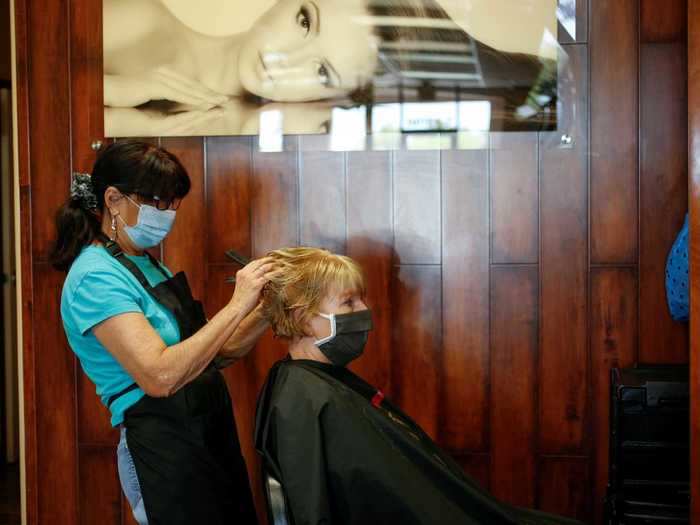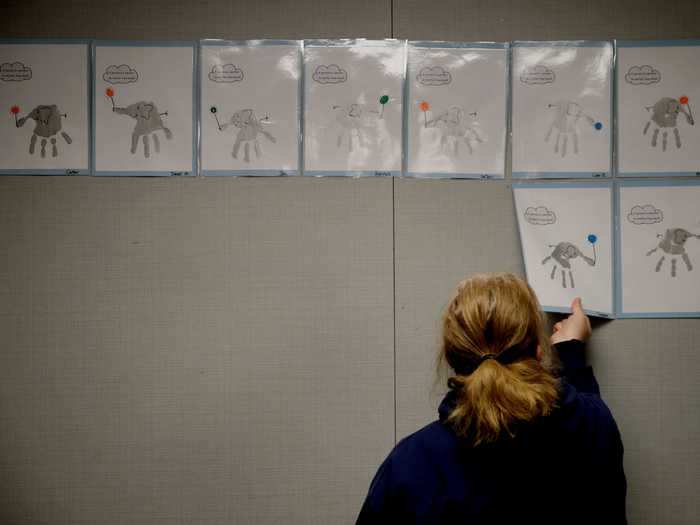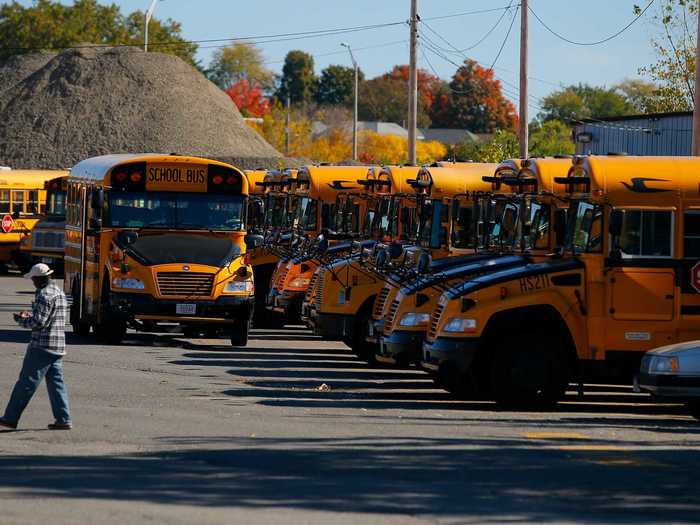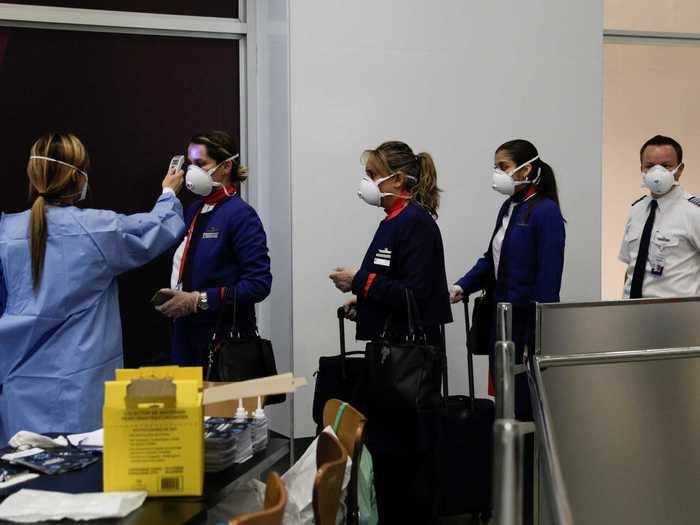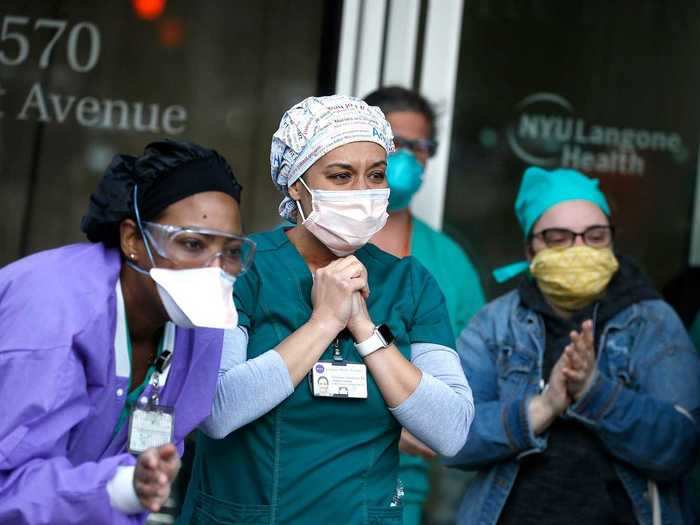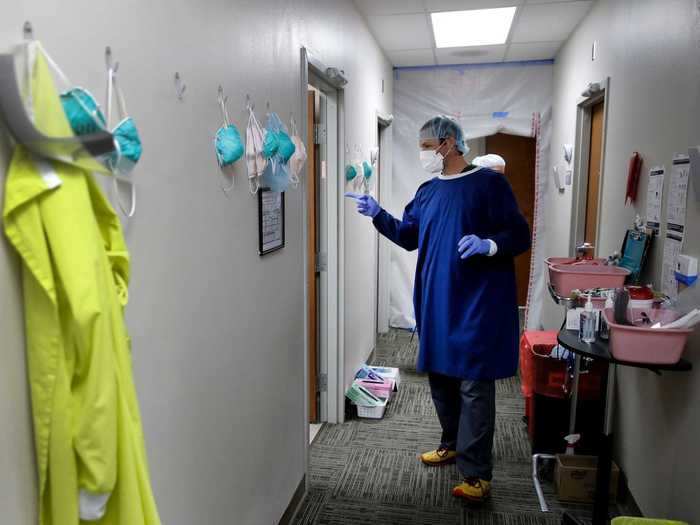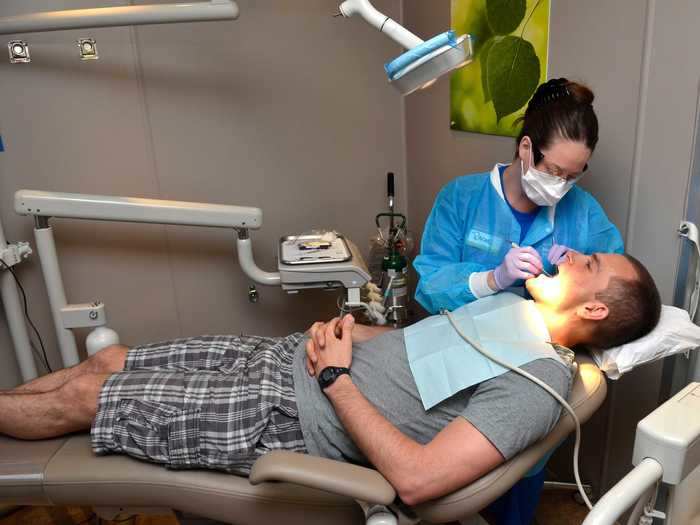A TSA officer wears a protective mask while screening travellers at Orlando International Airport.Paul Hennessy / Echoes Wire/Barcroft Media via Getty Images
- As more people go back to work as states ease their public health orders aimed to stem the spread of the coronavirus, some occupations are riskier than others.
- An analysis of coronavirus death rates by occupation and studies of occupations that pose the most risk to exposure help show which jobs carry higher risks.
- Some of the most dangerous jobs to have as lockdowns end include those in the healthcare, education, and restaurant industries.
As states ease or end their coronavirus lockdowns — despite rising cases, predominantly across the South — some jobs are riskier than others.
Neither the federal government nor any individual states have released occupational data related to COVID-19 deaths. The only data available at this point has been provided by the UK government's Office of National Statistics, which found that men in manual labor jobs with low pay were more likely to die from COVID-19. Security guards had the highest increased risk, as are medical professionals, factory workers, hairdressers, taxi drivers, restaurant and hospitality workers, and flight attendants.
"Jobs involving close proximity with others, and those where there is regular exposure to disease, have some of the highest rates of death from COVID-19," said Ben Humberstone, a statistician on the report. "However, our findings do not prove conclusively that the observed rates of death involving COVID-19 are necessarily caused by differences in occupational exposure."
Of the information available from the US National Center for Health Statistics, which is part of the Centers for Disease Control and Prevention, there are indications that the virus has disproportionately impacted workers in meatpacking plants, for example.
To examine which occupations are at most risk, Business Insider is using the Coronavirus Risk Score, a metric created by Visual Capitalist in collaboration with the World Economic Forum. The scores are based on data from the US Labor Department's O*NET database, which examines data points for various health risks — like the risk of exposure to diseases and infections, physical proximity to other people, direct contact with the public, and freedom to make decisions like being able to stay home if they or their family members are ill — for hundreds of occupations. We're also including income data and employment numbers from the US Bureau of Labor Statistics.
Here are nine of the most dangerous jobs to have as states reopen during the coronavirus pandemic.
9. Hairdressers
Donna Ferraro cuts and styles Jan Campbell's hair at Passions Salon during the phased reopening from coronavirus restrictions, in Cave Creek, Arizona, on May 11, 2020.
REUTERS/Nicole Neri/File Photo
Hairstyling requires direct contact with customers for a prolonged period of time, putting hairdressers at significant risk.
Other hands-on personal care services — including massage therapists, manicurists, and pedicurists — are also considered at high risk, according to the O*NET data.
Occupational risk score: 62.1
Average income: $24,730
Number employed: 377,210
8. Restaurant and hospitality workers
Many cities have reopened restaurants amid the coronavirus pandemic.
Irene Jiang / Business Insider
Restaurant jobs are some of the riskiest, according to the data.
The work most often requires employees to work in close quarters with not only other employees but also guests in an enclosed space. Employees of restaurants regularly exchange money with guests, come in contact with their used dishware, and do so in a setting without many of the precautions such as a glass separator or even masks.
In China, an asymptomatic patient died with their family on January 24 and it was reported that air droplets from that diner's breath were picked up by the air conditioning and blew around the room. Nine other people in the restaurant later tested positive and were traced to that individual.
First-line supervisors of food prep and serving workers are at the highest risk, according to the analysis, and account for one of the greatest numbers of employees in the country.
Occupational risk score: 62.8
Average income: $32,450
Number employed: 964,400
7. Firefighters
A Chicago firefighter watches the funeral procession for a firefighter who died from complications from the coronavirus in Chicago, Illinois, on April 22, 2020.
REUTERS/Shannon Stapleton
Firefighters are at a greater risk than police officers to contact COVID-19.
Firefighters across the US have been diagnosed with the virus and one of the biggest reasons for the spread within municipalities is that between calls, firefighters live together, eat together, and are used to spending nearly all of their time on call in the firehouse together.
Many firehouses are requiring firefighters to undergo temperature checks before the start of their shifts.
Firefighters are also reporting more fire incidents, as more people are staying at home cooking.
Occupational risk score: 63.2
Average income: $49,620
Number employed: 321,570
6. Kindergarten teachers
A a teacher removes students' artwork from a bulletin board as she packs the art in her kindergarten classroom at an elementary school in Olathe, Kansas, on May 12, 2020.
Associated Press
Teacher assistants, preschool teachers, and elementary teachers were also at high risk, according to the O*NET data, with kindergarten teachers deemed to be at the highest risk. Much like bus drivers, they're dealing with the risk of children who are too young to be counted on to follow protocols set for reopening of schools.
These youngins already have a hard time practicing proper hygiene and the impact of that falls on the kindergarten teachers who are in charge.
The near-term future of classroom learning is still unclear, but kindergarten teachers, in particular, are a greater risk than all other teachers, according to the data.
Occupational risk score: 65.8
Average income: $55,470
Number employed: 131,160
5. School bus drivers
School buses sit idle at a bus yard in Boston, Massachusetts, on October 8, 2013.
REUTERS/Brian Snyder
Driving a school bus also was found to be one of the most at-risk occupations to contract the virus, according to World Economic Forum's figures, due to the fact drivers work in close proximity to others and the exposure to many people in a day.
Although the majority of states have mandated school closures through the end of the school year, the job remains one of the more at-risk professions as the world faces the risk of a second wave in the fall.
Many drivers are in the at-risk category due to their ages and medical conditions, according to a report in School Transportation News, and there may be a driver shortage when school returns.
Drivers are concerned that children will not take the COVID precautions seriously, and some states are considering putting aids on buses to make sure children are taking the proper precautions, according to New York-based Spectrum News.
Occupational risk score: 67.3
Average income: $32,420
Number employed: 504,150
4. Flight attendants
Rio de Janeiro's health surveillance members in protective gear check the body temperature of flight attendants arriving in Galeao Internacional Airport in Rio de Janeiro, Brazil, March 25, 2020.
Ricardo Moraes/Reuters
Flight attendants were found to be at the most risk of being exposed to disease or infections of all professions outside medical and health-care related jobs, according to the O*NET data. This shouldn't come as a surprise, as these workers are in close contact with hundreds of passengers each flight. They are also at risk during their "commutes" at multiple airports each day.
One of the biggest risks for flight attendants is the unknown, as screenings are U.S. airports for the virus are nonexistent. The federal government does not have a plan to screen for fevers for domestic flights and it has been left up to the individual airlines, according to USA Today.
Occupational risk score: 75.6
Average income: $56,000
Number employed: 118,770
3. Registered nurses
Nurses and medical staff stand outside NYU Langone Hospital as people cheer to show their gratitude to medical staff during the daily "Clap Because We Care" initiative in May.
John Lamparski/Getty Images
Nurses are on the frontlines of the pandemic, both in the ER dealing with patients in intensive care in close proximity to aerosol-producing ventilators, as well as on cleanup duty performing a lot of the dirty work in hospitals and doctors' offices.
Other types of nurses and medical assistants, including licensed practical and licensed vocational nurses, physician assistants, and nursing assistants, are also considered high risk, according to the O*NET data.
Due to their contact with a high number of COVID-19-positive patients each day, nurses are at greater risk than ER doctors and other hospital-based staff.
Nurses also make up the greatest number of employees of any category on our list with 2,951,960 registered nurses currently working in the US.
Occupational risk score: 86.1
Average income: $71,730
Number of employed: 2,951,960
2. Family and general practitioners
Dr. Drew Miller wears a homemade gown as he prepares to see potential COVID-19 patients at the 24-bed Kearny County Hospital in Lakin, Kansas, on May 20, 2020.
Charlie Riedel/AP Photo
Unsurprisingly, family doctors are at a high risk of contacting COVID-19, as they are the first point of contact for most people who suspect they may have the virus, especially in areas and states with limited testing capabilities. Other kinds of doctors and medical workers, including specialists like surgeons and anesthesiologists, are also highly at risk, according to O*NET data.
One of the biggest risk factors for general practitioners is a lack of guidance from authorities on how to safeguard within the practices and a lack of preparation for a pandemic, according to BMJ, one of the world's oldest medical journals.
"Every doctor I spoke with reported feeling whip-sawed by constantly changing guidance from experts and regulators about coronavirus testing and triage policies," wrote Douglas Kamerow, senior scholar, Robert Graham Center for policy studies in primary care and associate editor of the BMJ. "They were often confused by changing recommendations from trusted sources, as well as conflicting recommendations from local, state, medical specialty, and federal authorities.
Occupational risk score: 90.1
Average income: $201,100
Number employed: 114,130
1. Dental hygienists
Dental Hygienist Rachel Reed works on John Higgins in the MouthMobile truck at the Aspen Dental Healthy Mouth Movement in Syracuse, New York, on May 13, 2014.
Kevin Rivoli/AP
Dental hygienists have the highest risk score for contracting with the coronavirus, according to the World Economic Forum analysis.
They spend extended periods of time in close proximity to patients' mouths and perform procedures that produce aerosols, which can carry the virus.
Some dentists' offices have taken steps to prevent aerosol spread, such as having staff wear face shields and scrape teeth by hand instead of using machines that spray air and water, according to WBUR. Many dental procedures and check-ups were also postponed while state lockdowns were in effect.
Occupational risk score: 99.7
Average income: $74,820
Number employed: 215,150

